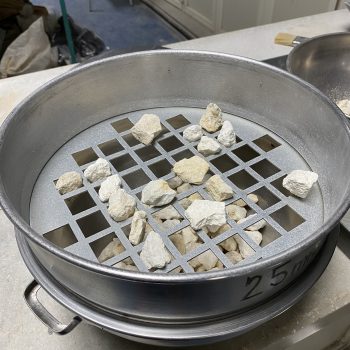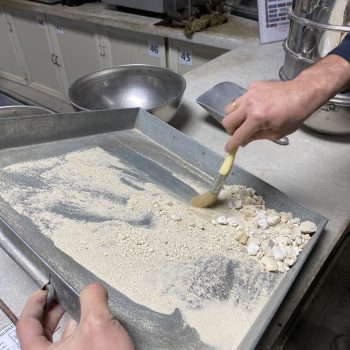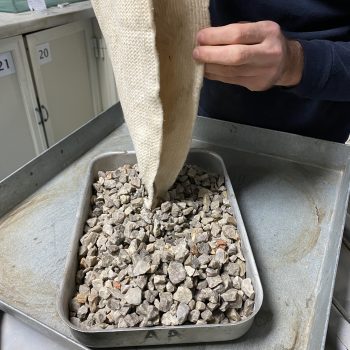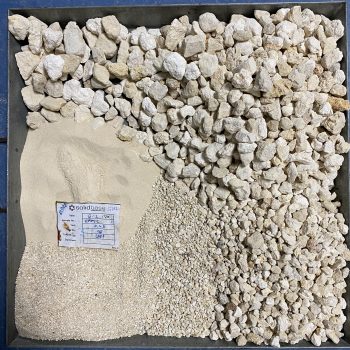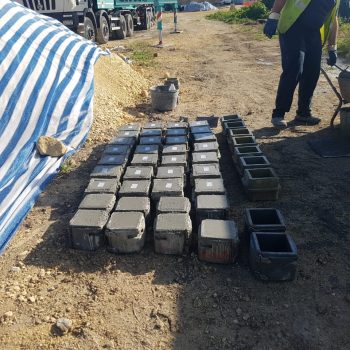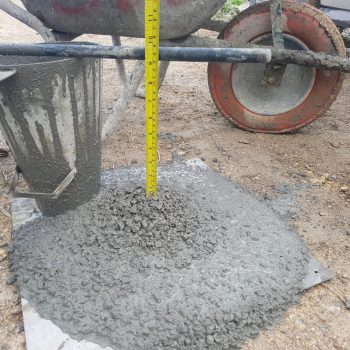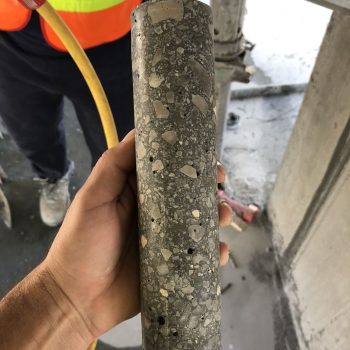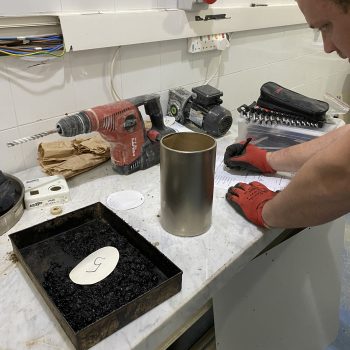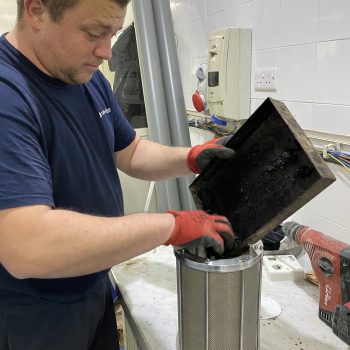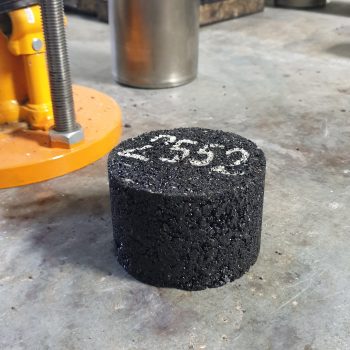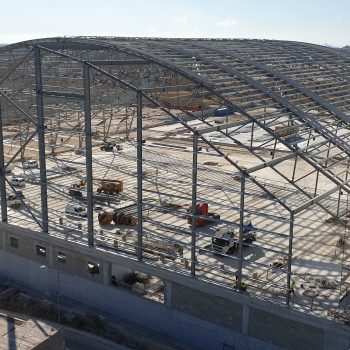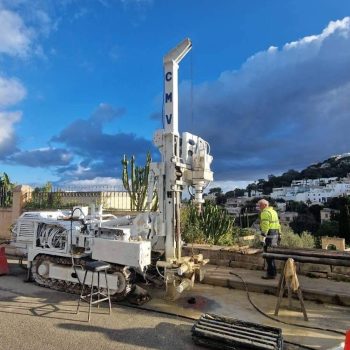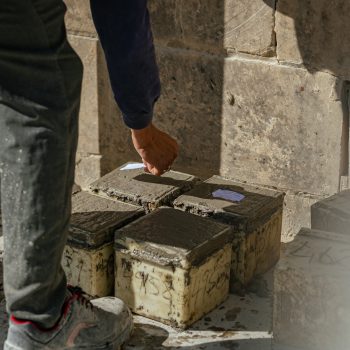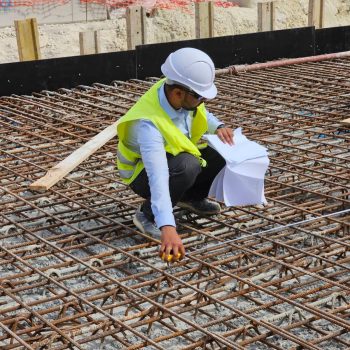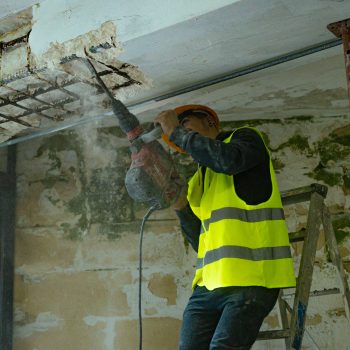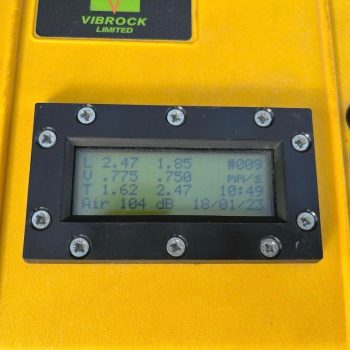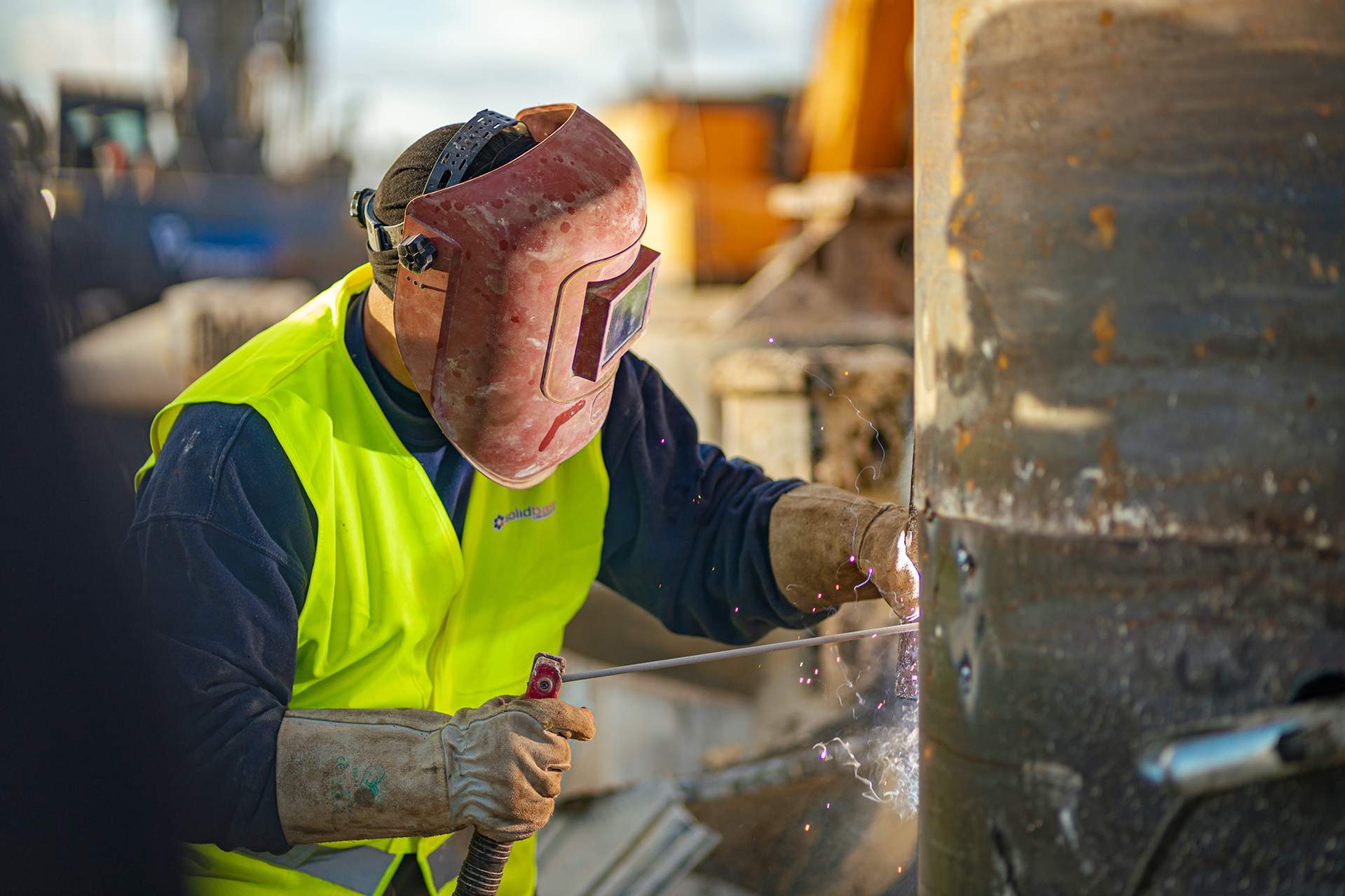The durability and life expectancy of a structure is only as good as the quality of its poorest ingredient.
Aggregate Testing
Quality control in construction projects involves rigorous testing of various materials to ensure structural integrity and longevity. Aggregate testing plays a pivotal role in assessing the suitability of aggregates used in concrete and asphalt production. It includes meticulous examinations such as sampling, measuring moisture content, analyzing particle size distribution, and determining properties like LA abrasion, particle density, water absorption, and bulk density. These tests guarantee that the aggregates meet specified standards, ensuring the durability of the resulting structures.
Sampling as per Standard EN 932-1
Although we do accept samples taken by our clients, we recommend that our technicians carry out this important part of every test to obtain representative samples as this has a major influence on test results.
Moisture Content and Particle Size Distribution as per Standard EN 1097-5 and EN 933-1
These important classification tests assist in supply control as well as in the determination of the characteristics of materials for suitability of use. Results are also used in the production of concrete and asphalt mix designs.
Los Angeles (LA) Abrasion as per Standard EN 1097-2
The resistance to fragmentation by the Los Angeles test is the aggregate strength test procedure currently valid in the EN standard test range. We also carry out the Aggregate Impact Value test (AIV), Ten Percent Fines Value (TFV) as well as Aggregate Crushing Value (ACV). Accreditation for these tests is not available since the tests have been superseded by CEN and CENELEC, European Standardization Organizations.
Particle Density and Water Absorption as per Standard EN1097-6
The density is defined as mass per unit volume. We are equipped to carry out multiple concurrent determinations. Test results give insight into aggregate quality and are used in the determination of trial mix constituents.
Flakiness and Particle Shape as per Standard EN933-3 and 933-4
The shape of aggregate particles can be classified as either cubical, non-cubical, angular, subangular, subrounded or rounded. Aggregate particle shape is directly proportional to its strength.
Bulk Density as per Standard EN1097-3 and EN1097-7
The bulk density of aggregates is the mass of the aggregate required to fill a container of a unit volume. The result of this test may be used in determining mass/volume relationships for conversions in purchase agreements. The bulk density affects the mix design, workability, and unit weight behavior.
Concrete Testing
Concrete testing is crucial to guarantee the strength and durability of concrete structures. Engineers assess various aspects, such as cement fineness, setting time, and strength development. The process includes concrete sampling, creating test specimens like slump and cubes, and evaluating air content in fresh concrete. Moreover, the density of both fresh and hardened concrete is examined, along with compressive strength analysis of concrete cubes and cores. These tests assure that the concrete used in construction possesses the necessary strength and resistance to external factors.
Cement Fineness, Setting Time and Strength as per Standards EN 196-6, EN 196-3 and EN 196-1
These properties of cement have a direct relationship to the finished product, both in terms of workability and placement, as well as final product strength.
Concrete Sampling, Slump and Cube Making as per Standards EN 12350-1, EN 12350-2 and EN 12390-2
Although we accept cubes made by clients, they may have to be rejected unless they conform to rigid standard tolerances. When our representatives are on site, they can report on the workability to the client’s representative immediately.
Air Content of Fresh Concrete as per Standard EN 12350:7
This is an important aspect in the calculation in concrete trial mix design.
Fresh and Hard Concrete Density as per Standards EN 12350-6 and EN 12390-7
All concrete raw ingredients come together to produce concrete of differing properties. Concrete density gives an overall indication of the quality of the raw ingredients and the batching weight per unit volume.
Concrete Cube and Core Compressive Strength as per Standard EN 12390-3
Ultimately, it is the strength of a concrete that dictates its suitability for the element into which it is cast. This is the most important of all concrete analysis.
Water Absorption and Chloride Penetration as per Standard BS 1881-122:2011 and ASTM C 1202-2012
The effects of concrete water absorption and chloride penetration are directly related to its durability. Both tests can be carried out on hardened concrete to assess its characteristics or on samples made or provided to forecast the concrete’s performance.
Asphalt Testing
Asphalt testing focuses on the properties of asphalt mixtures, which are fundamental in road construction. Engineers examine aspects like sampling techniques, temperature susceptibility, binder content, grading, flow, and stability of the asphalt mix. Moreover, tests such as the Leutner Shear Test assess the resistance of the asphalt mix against shear forces. Theoretical specific gravity and voids content analysis, along with evaluating road surface irregularities, density, and compaction tests, ensure the longevity and stability of road surfaces. Asphalt mix design plays a vital role in constructing roads that withstand the wear and tear of vehicular traffic and environmental factors.
Sampling and Temperature as per Standards EN 12697-27 and EN 12697-13
Whether during or after laying, sampling is a very important part of asphalt analysis since poor sampling may lead to poor result performance.
Binder Content, Grading Flow and Stability a per Standards EN 12697-32-, EN 12697-1, EN 12697-2, EN 12697-30, EN 12390-7 and EN 12697-34
This suite of tests reveal the properties of a batch of asphalt: strength, make up, and flexibility. In turn, they are compared against minimum requirements from the contracting authority.
Theoretical Specific Gravity and Voids Content as per Standards EN 12697-5 and EN 12697-8
The theoretical maximum specific gravity is the specific gravity excluding air voids in a given sample. These details are used both in the determination of voids in a cored sample as well as during mix design stage.
Road Surface Irregularity as per Standard Specification for Road Works Series 700 cl 7.2
This test identifies the ride quality of a stretch of road, which, at the end of the day, is what road goers are most interested in. Any undulations in the finished surface are identified.
Leutner Shear Test, Density and Compaction as per Standard EN 126976
These tests quantify the bond between asphalt layers as well as the degree to which they are compacted. The latter is then compared to the density of laboratory compacted samples which represents the best attainable on the material for an evaluation of what the situation on site actually is.
Asphalt Mix Design – Marshall Method
Asphalt consists of aggregate and asphalt binder. A mix design determines what quality and amount of raw materials are to be used and what the optimum combination of these are based on the results of tests carried out on the raw materials. When aggregate and bitumen are combined to produce asphalt, the latter performs differently to the properties of its components. Laboratory trial mixes are used to characterize the mixture proportions and to predict the end product properties.
Soil Testing
In soil testing, engineers assess the properties of soil samples to understand their behavior under different conditions. Parameters like Atterberg limits (liquid and plastic limits), Optimum Moisture Content (OMC) and Maximum Dry Density (MDD), rock cores analysis, Standard Penetration Test (SPT), and triaxial shear strength are evaluated. This comprehensive analysis aids in making informed decisions about foundation design, ensuring stability and safety in construction projects.
Atterberg Limits as per Standard BS 1377 Part 2
A fine-grained soils such as clay can exist in various states which depends on its water content. When water is added to a dry soil, each particle is covered with a film of absorbed water. If the addition of water is continued, the thickness of the water film on a particle increases. This increase permits the particles to slide past one another more easily. The behaviour of the soil, therefore, is related to the amount of water contained. These tests identify characteristics of soils.
OMC and MDD as per Standard BS 1377-4
This test is carried out to determine the maximum dry density and the optimum moisture content of a soil using heavy compaction. Results are then used to compare compactions achieved on site, determined by the sand replacement density test (see below).
Rock Cores – Standards: ISRM Suggested Method for Determination of the Uniaxial Compressive Strength of Rock Materials, ET Brown. ISRM Suggested Method for Determination of the Uniaxial Compressive Strength of Rock Materials, Modified by Annex W, ‘Strength Testing of Rock Material’ of EN 1997-2
The unconfined compressive strength test is that most commonly used for for strength determination on rock core specimens. Samples obtained by core drilling are trimmed to obtain a length / diameter ratio of 2 to 2.5. The ends of the specimen are trimmed flat and smooth, parallel, and exactly perpendicular to the axis of the core. The specimen is placed in a compression testing machine and subjected to compression with an automatically controlled pace rate. The peak load achieved is divided by the area of specimen to obtain the final result.
Sand Replacement Density as per Standard BS 1377-9
The SRD test is used to measure the in-situ density of compacted soils using calibrated sand and a sand pouring cylinder. The SRD result is expressed as a percentage of the laboratory MDD (above) results to estimate the degree of compaction of road sub-base materials.
Triaxial Shear Strength as per Standard BS 1377-9 Part 8
A triaxial shear test is a common method to measure the mechanical properties, mainly strength, of clays and other granular materials.
Shear Strength as per Standard BS 1377-7
The direct shear test is used to measure the shear strength properties of soil, rock, or discontinuities in soil or rock masses.
Other Laboratory Tests
California Bearing Ratio (CBR) as per Standard BS 1377-9
We carry out the CBR test as a lab test. It measures the pressure required to penetrate a soil sample with a plunger of standard cross-sectional area. The force required is then divided by that required to achieve an equal penetration on a standard crushed rock material. The better quality the sample, the higher the CBR value.
Masonry Blocks and Paving Blocks as per Standards EN 772-1, EN 772-16, EN 1338 and EN 1339
Masonry and paving blocks are measured, prepared, and cured for compression testing. A uniformly distributed load is applied and increased continuously to failure. The peak load is expressed as a force / surface area value.
Tiles as per Standards EN 13748-1, EN 13748-2 and EN 10545-4
Depending on the type of tile submitted for testing, the following tests can be carried out:
– Moisture content
– Transverse strength
– Dimensions & appearance
– Water absorption (total and / or face)
– Transverse Strength
– Dimensions & Appearance
Kerbs as per Standard EN 1340
The standard defining tests on kerb specifies the materials, properties, requirements, and test methods for unreinforced, cement bound precast concrete kerb units, channels and complementary fittings, that are for use in trafficked paved areas.
Water as per Standard EN 1008
The suite we carry out for water testing is for suitability of use in concrete. The following tests can be carried out: chlorides, sulphates.
Steel Reinforcement as per Standard EN 10002-1
Steel reinforcement bar, or rebar, is embedded in concrete to improve the overall strength of the concrete element it forms part of. Testing is carried out to determine whether the rebar meets specifications required.
Insitu Tests
In addition to laboratory testing, insitu tests are crucial in evaluating the existing conditions of construction sites and structures.
Plate Bearing Tests as per Standard DIN 18134
The plate bearing test is an in-situ test to determine the ultimate bearing capacity of layers of soil that form a carriageway and the potential settlement under load. The test consists of loading a standard diameter plate, unloading it, and subsequent reloading. The settlement corresponding to the load increments applied is evaluated as a load-settlement curve.
Schmidt (Rebound) Hammer Survey as per Standard EN 12504-2
The Schmidt hammer is a spring-loaded device which provides rebound valves when the force is applied to a concrete surface. These values are correlated to compressive strength by using the conversation table provided with the hammer. The Schmidt hammer is mainly a surface hardness test and is not designed to give strength indication at depth.
Cover Meter Survey as per Standard BS 1881-204
A cover meter is an electromagnetic device that may be used for estimating the position, depth and size of reinforcement buried in concrete.
Pull-Off Tests as per Standard EN 1542
The pull-off apparatus produces results that correlate to the compressive strength of the concrete under examination. The correlation is achieved by measuring the force required to pull a metallic disc which has been securely affixed to the surface off the concrete.
Clegg Hammer Survey as per Standard ASTM D5874
The Clegg impact soil tester measures the strength of a compacted soil. It is used to identify poorly compacted areas and ineffective compaction of road sub-base. The results are comparable to equivalent in-situ CBR results. Although not as accurate as the CBR test, a Clegg hammer survey can give better coverage and can be used in areas where other tests can’t be carried out because of mobilisation and / or setup issues.
Hardened Concrete Sounding Survey as per Standard In-house method QF-380.001
This test follows an in-house developed procedure in which a concrete surface is struck with a standard weight hammer and the resulting sound evaluated for subsurface voids.

